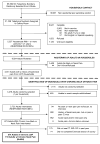Exercise prescription for chronic back or neck pain: who prescribes it? who gets it? What is prescribed?
- PMID: 19177524
- PMCID: PMC4339066
- DOI: 10.1002/art.24234
Exercise prescription for chronic back or neck pain: who prescribes it? who gets it? What is prescribed?
Abstract
Objective: To describe exercise prescription in routine clinical practice for individuals with chronic back or neck pain because, although current practice guidelines promote exercise for chronic back and neck pain, little is known about exercise prescription in routine care.
Methods: We conducted a computer-assisted telephone survey of a representative sample of individuals (n = 684) with chronic back or neck pain who saw a physician, chiropractor, and/or physical therapist (PT) in the past 12 months. Individuals were asked about whether they were prescribed exercise, the amount of supervision received, and the type, duration, and frequency of the prescribed exercise. Descriptive and multivariable regression analyses were conducted.
Results: Of the 684 subjects, 48% were prescribed exercise. Of those prescribed exercise, 46% received the prescription from a PT, 29% from a physician, 21% from a chiropractor, and 4% from other. In multivariable analyses, seeing a PT or a chiropractor were the strongest predictors of exercise prescription. The likelihood of exercise prescription was increased in women, those with higher education, and those receiving worker's compensation. PTs were more likely to provide supervision and prescribe strengthening exercises compared with physicians and chiropractors, and were more likely to prescribe stretching exercises compared with physicians.
Conclusion: Our findings suggest that exercise is being underutilized as a treatment for chronic back and neck pain and, to some extent, that the amount of supervision and types of exercises prescribed do not follow current practice guidelines. Exercise prescription provided by PTs appears to be most in line with current guidelines.
Similar articles
-
Predictive factors of adherence to frequency and duration components in home exercise programs for neck and low back pain: an observational study.BMC Musculoskelet Disord. 2009 Dec 9;10:155. doi: 10.1186/1471-2474-10-155. BMC Musculoskelet Disord. 2009. PMID: 19995464 Free PMC article.
-
How do care-provider and home exercise program characteristics affect patient adherence in chronic neck and back pain: a qualitative study.BMC Health Serv Res. 2010 Mar 10;10:60. doi: 10.1186/1472-6963-10-60. BMC Health Serv Res. 2010. PMID: 20219095 Free PMC article.
-
A comparison of analgesic prescribing among ED back and neck pain visits receiving physical therapy versus usual care.Am J Emerg Med. 2019 Jul;37(7):1322-1326. doi: 10.1016/j.ajem.2018.10.009. Epub 2018 Oct 23. Am J Emerg Med. 2019. PMID: 30528050
-
Back and neck pain: in support of routine delivery of non-pharmacologic treatments as a way to improve individual and population health.Transl Res. 2021 Aug;234:129-140. doi: 10.1016/j.trsl.2021.04.006. Epub 2021 Apr 24. Transl Res. 2021. PMID: 33901699 Free PMC article. Review.
-
Non-pharmacological management of persistent headaches associated with neck pain: A clinical practice guideline from the Ontario protocol for traffic injury management (OPTIMa) collaboration.Eur J Pain. 2019 Jul;23(6):1051-1070. doi: 10.1002/ejp.1374. Epub 2019 Feb 28. Eur J Pain. 2019. PMID: 30707486 Review.
Cited by
-
Central neurobiological effects of physical exercise in individuals with chronic musculoskeletal pain: a systematic review.BMJ Open. 2020 Jul 6;10(7):e036151. doi: 10.1136/bmjopen-2019-036151. BMJ Open. 2020. PMID: 32636282 Free PMC article.
-
Changes in disability, physical/mental health states and quality of life during an 8-week multimodal physiotherapy programme in patients with chronic non-specific neck pain: a prospective cohort study.PLoS One. 2015 Feb 24;10(2):e0118395. doi: 10.1371/journal.pone.0118395. eCollection 2015. PLoS One. 2015. PMID: 25710539 Free PMC article. Clinical Trial.
-
Cost-effectiveness of spinal manipulative therapy, supervised exercise, and home exercise for older adults with chronic neck pain.Spine J. 2016 Nov;16(11):1292-1304. doi: 10.1016/j.spinee.2016.06.014. Epub 2016 Jun 23. Spine J. 2016. PMID: 27345747 Free PMC article. Clinical Trial.
-
Managing patients with acute and chronic non-specific neck pain: are Danish chiropractors compliant with guidelines?Chiropr Man Therap. 2017 Jun 30;25:17. doi: 10.1186/s12998-017-0148-9. eCollection 2017. Chiropr Man Therap. 2017. PMID: 28670442 Free PMC article.
-
Fast tracking the design of theory-based KT interventions through a consensus process.Implement Sci. 2015 Feb 11;10:18. doi: 10.1186/s13012-015-0213-5. Implement Sci. 2015. PMID: 25880218 Free PMC article.
References
-
- Rainville J, Hartigan C, Martinez E, Limke J, Jouve C, Finno M. Exercise as a treatment for chronic low back pain. Spine J. 2004;4:106–15. - PubMed
-
- Chou R, Huffman LH. Nonpharmacologic therapies for acute and chronic low back pain: a review of the evidence for an American Pain Society/American College of Physicians clinical practice guideline. Ann Intern Med. 2007;147:492–504. - PubMed
-
- Chou R, Qaseem A, Snow V, et al. Diagnosis and treatment of low back pain: a joint clinical practice guideline from the American College of Physicians and the American Pain Society. Ann Intern Med. 147:478–91. - PubMed
-
- Hayden JA, van Tulder MW, Malmivaara AV, Koes BW. Meta-analysis: exercise therapy for nonspecific low back pain. Ann Intern Med. 2005;142:765–75. - PubMed
Publication types
MeSH terms
Grants and funding
LinkOut - more resources
Full Text Sources
Medical
Miscellaneous


